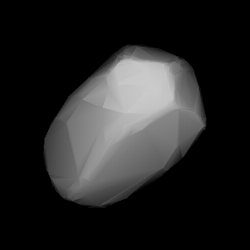 Shape model of Lampland from its lightcurve Shape model of Lampland from its lightcurve | |
| Discovery | |
|---|---|
| Discovered by | Indiana University (Indiana Asteroid Program) |
| Discovery site | Goethe Link Obs. |
| Discovery date | 7 September 1962 |
| Designations | |
| MPC designation | (1767) Lampland |
| Named after | Carl Lampland (American astronomer) |
| Alternative designations | 1962 RJ · 1941 SP 1967 SC |
| Minor planet category | main-belt · (outer) Eos |
| Orbital characteristics | |
| Epoch 4 September 2017 (JD 2458000.5) | |
| Uncertainty parameter 0 | |
| Observation arc | 75.52 yr (27,585 days) |
| Aphelion | 3.3209 AU |
| Perihelion | 2.7160 AU |
| Semi-major axis | 3.0185 AU |
| Eccentricity | 0.1002 |
| Orbital period (sidereal) | 5.24 yr (1,915 days) |
| Mean anomaly | 201.21° |
| Mean motion | 0° 11 16.44 / day |
| Inclination | 9.8418° |
| Longitude of ascending node | 192.22° |
| Argument of perihelion | 135.41° |
| Physical characteristics | |
| Dimensions | 15.448±2.805 km |
| Geometric albedo | 0.116±0.057 |
| Spectral type | Tholen = XC B–V = 0.750 U–B = 0.340 |
| Absolute magnitude (H) | 12.20 |
1767 Lampland, provisional designation 1962 RJ, is an Eoan asteroid from the outer regions of the asteroid belt, approximately 15 kilometers in diameter. It was discovered on 7 September 1962, by astronomers of the Indiana Asteroid Program at Goethe Link Observatory in Indiana, United States. The asteroid was named after American astronomer Carl Lampland.
Orbit and classification
Lampland a member the Eos family (606), the largest asteroid family in the outer main belt consisting of nearly 10,000 asteroids. It orbits the Sun at a distance of 2.7–3.3 AU once every 5 years and 3 months (1,915 days). Its orbit has an eccentricity of 0.10 and an inclination of 10° with respect to the ecliptic.
The asteroid was first identified as 1941 SP at Uccle Observatory in September 1941. The body's observation arc begins with a precovery at Palomar Observatory in August 1951, more than 11 years prior to its official discovery observation at Goethe Link.
Physical characteristics
In the Tholen classification, its spectral type is ambiguous, closest to the X-type asteroid and with some resemblance to the C-type asteroids, while the overall spectral type of the Eos family is that of a K-type.
Rotation period
As of 2017, no rotational lightcurve of Lampland has been obtained from photometric observations. The asteroid's rotation period, poles and shape remain unknown.
Diameter and albedo
According to the survey carried out by the NEOWISE mission of NASA's Wide-field Infrared Survey Explorer, Lampland measures 15.448 kilometers in diameter and its surface has an albedo of 0.116.
Naming
This minor planet was named after American astronomer Carl Lampland (1873–1951), a graduate of Indiana University, best known for his radiometric measurements of planetary temperatures.
Lampland is also honored by a lunar and by a Martian crater. The name was proposed by Frank K. Edmondson, who initiated the Indiana Asteroid Program. The official naming citation was published by the Minor Planet Center on 20 February 1971 (M.P.C. 3144).
References
- ^ "JPL Small-Body Database Browser: 1767 Lampland (1962 RJ)" (2017-03-30 last obs.). Jet Propulsion Laboratory. Retrieved 6 September 2017.
- ^ Schmadel, Lutz D. (2007). "(1767) Lampland". Dictionary of Minor Planet Names. Springer Berlin Heidelberg. p. 141. doi:10.1007/978-3-540-29925-7_1768. ISBN 978-3-540-00238-3.
- ^ "Asteroid 1767 Lampland – Nesvorny HCM Asteroid Families V3.0". Small Bodies Data Ferret. Retrieved 26 October 2019.
- ^ Masiero, Joseph R.; Mainzer, A. K.; Grav, T.; Bauer, J. M.; Cutri, R. M.; Nugent, C.; et al. (November 2012). "Preliminary Analysis of WISE/NEOWISE 3-Band Cryogenic and Post-cryogenic Observations of Main Belt Asteroids". The Astrophysical Journal Letters. 759 (1): 5. arXiv:1209.5794. Bibcode:2012ApJ...759L...8M. doi:10.1088/2041-8205/759/1/L8. Retrieved 6 September 2017.
- ^ Nugent, C. R.; Mainzer, A.; Masiero, J.; Bauer, J.; Cutri, R. M.; Grav, T.; et al. (December 2015). "NEOWISE Reactivation Mission Year One: Preliminary Asteroid Diameters and Albedos". The Astrophysical Journal. 814 (2): 13. arXiv:1509.02522. Bibcode:2015ApJ...814..117N. doi:10.1088/0004-637X/814/2/117. Retrieved 6 September 2017.
- ^ "1767 Lampland (1962 RJ)". Minor Planet Center. Retrieved 6 September 2017.
- ^ Nesvorný, D.; Broz, M.; Carruba, V. (December 2014). "Identification and Dynamical Properties of Asteroid Families". Asteroids IV. pp. 297–321. arXiv:1502.01628. Bibcode:2015aste.book..297N. doi:10.2458/azu_uapress_9780816532131-ch016. ISBN 9780816532131.
- "LCDB Data for (1767) Lampland". Asteroid Lightcurve Database (LCDB). Retrieved 6 September 2017.
- Schmadel, Lutz D. (2009). "Appendix – Publication Dates of the MPCs". Dictionary of Minor Planet Names – Addendum to Fifth Edition (2006–2008). Springer Berlin Heidelberg. p. 221. doi:10.1007/978-3-642-01965-4. ISBN 978-3-642-01964-7.
External links
- Asteroid Lightcurve Database (LCDB), query form (info Archived 16 December 2017 at the Wayback Machine)
- Dictionary of Minor Planet Names, Google books
- Asteroids and comets rotation curves, CdR – Observatoire de Genève, Raoul Behrend
- Discovery Circumstances: Numbered Minor Planets (1)-(5000) – Minor Planet Center
- 1767 Lampland at AstDyS-2, Asteroids—Dynamic Site
- 1767 Lampland at the JPL Small-Body Database

| Minor planets navigator | |
|---|---|
| Small Solar System bodies | |||||||
|---|---|---|---|---|---|---|---|
| Minor planets |
| ||||||
| Comets | |||||||
| Other | |||||||